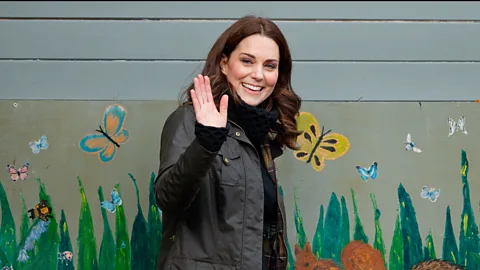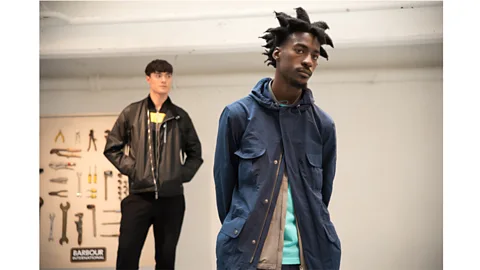How the Barbour became the ultimate British symbol
 Getty Images
Getty ImagesFrom the Royal Family to Glastonbury, the Barbour jacket – in all its slightly dishevelled glory – has come to symbolise Britishness. Lindsay Baker traces the life and times of an iconic garment.
It would be hard to imagine a more quintessentially British garment than the venerable Barbour jacket – the famed olive-green, wax coated, all-weather wardrobe staple beloved by the Royal Family. So it makes perfect sense that UK Prime Minister Rishi Sunak offered a personalised version of the iconic jacket to President Biden when the two met yesterday. As an offering it's a symbol of Britishness, and the pair's bromance – the jacket is customised, with the moniker "Mr President" embroidered on the front.
More like this:
It's a personal gift, and also a symbolic one. The high-end, family-owned Barbour brand is based near the PM's constituency in the Northeast of England and is a British institution. Mr Sunak himself is a fan and has been seen frequently sporting the brand. It was the late Queen and US movie icon and motorcycle enthusiast Steve McQueen who were at one point the two most iconic Barbour wearers.
 Getty Images
Getty ImagesAnd the Barbour has become increasingly popular in US in recent years – an article in The Spectator by a US writer describes "How the Barbour cracked America". It has increasingly been seen on TV screens in episodes of Succession – sported mainly by the patriarch Logan Roy – Industry, and, most notably, The Crown.
Traditionally the brand is synonymous with the British upper classes, a horsey, hunting staple on a par with Land Rovers and Hunter wellington boots. It shares a similar cachet to Burberry or Harris Tweed – a signifier of class, history, heritage and quality. But the trajectory of Barbour is a nuanced one, and its appeal now much wider.
Rural origins
Founded by Scotsman John Barbour in 1894 in Newcastle's South Shields, the brand began strictly as utilitarian wear for the countryside, for hunting and fishing. There were pockets for storing gaming cartridges, the "thornproof" wax coating for scrambling through hostile brambly countryside, and some versions even have a capacious "game pocket" with enough space for an entire pheasant. Another style is cut short for easy horseback riding.
The jackets over time develop a shabby patina, lending them a charmingly dishevelled character – there is traditionally a cachet attached to the well-worn Barbour. They also emit an unmistakeably musty odour, emanating from the wax coating.

In 1972 Dame Margaret Barbour took over the family business and introduced new styles. And soon after, when the soon-to-be Princess Diana entered the public consciousness, the golden age of the Barbour followed. The young Lady Diana Spencer helped popularise the garment in the late 1970s and early 80s, and the jacket became a shorthand, go-to garment for the Sloane Ranger, which, like its preppy counterpart in the US, was becoming an increasingly recognisable tribe. The popular book The Official Sloane Ranger Handbook by Peter York and Ann Barr sealed the Sloane's unmistakeable identity. Diana in her Barbour and pearls was the Sloane poster girl.
As the Sloane ethos (polo, pearls, champagne, white privilege) fell from favour, it wasn't long before the Barbour look became fashionable again – this time via that bastion of Britishness, Glastonbury Festival; it soon became the unofficial uniform for muddy festival outings, often paired with wellies and a mini dress. In 2013 the willowy It girl and Glastonbury fan Alexa Chung collaborated with the brand to create jackets with an Alexa-style twist, and the partnership is ongoing – the most recent collection was inspired by Glastonbury in the 1990s. Chung told Vogue last year: "I suppose we're all hankering for a time before everything was performance, and my preoccupation with practical things worn with more frivolous things is on perfect display at a music festival."
In 2020, the brand made a bold transition from rural to urban when – like other "heritage" fashion houses – it dipped its toes into streetwear. The collaboration with skate label-turned influential fashion powerhouse Supreme, with a range of waxed cotton jackets and accessories, was a radical departure for Barbour – but somehow it worked. Another unlikely alliance came last year, when cool Scandi-chic label Ganni partnered with the heritage brand. The waxy cotton macs were adorned with a joint logo, and the check quilted coats and bucket hats that, according to Vogue present a "cool-girl" look. Ganni X Barbour also included a "re-loved" offering, comprising 50 upcycled and reworked jackets.
Long-lasting luxury
It's this re-loved aspect of the Barbour jacket that perhaps is the most significant of all in terms of its continuing relevance. The brand has recently launched its Wax for Life initiative, a service that will re-wax, mend or customise your existing Barbour. They are, after all, the jackets that last forever – the more beaten-up looking the better. The eco-conscious King Charles has worn his Barbour for decades; Queen Elizabeth wore hers for 25 years and refused a new one offered to her by the brand for her recent Jubilee.
 Getty Images
Getty ImagesAt the Barbour HQ in Newcastle, an archive features jackets dating back over the decades. The director of menswear Ian Bergin recently told Elle: "The way the jackets have evolved from a design point of view, they're quite understated, so they're very wearable... Because intrinsically they're designed for a purpose, they tend to last a long time in terms of trend. So, they cut through that which I think is the biggest factor in [the sustainability] sense."
There is a sense of longevity and quiet, understated luxury that goes hand in hand with Barbour's status as a family-owned business that has been passed down through the generations. From countryside English girl to urban skate kid; from the Queen to Steve McQueen; from the muddy, elite polo field to the muddy, egalitarian festival field; from 19th Century hunting and fishing to 21st Century upcycling, the all-encompassing Barbour has had quite a journey. It is the perfect soft power gift, hinting gently at many different, hard-to-define qualities – history, consistency, functionalism, longevity, family, modernity, coolness, sustainability – and a hopeful eye on the future.
If you would like to comment on this story or anything else you have seen on BBC Culture, head over to our Facebook page or message us on Twitter.
And if you liked this story, sign up for the weekly bbc.com features newsletter.
